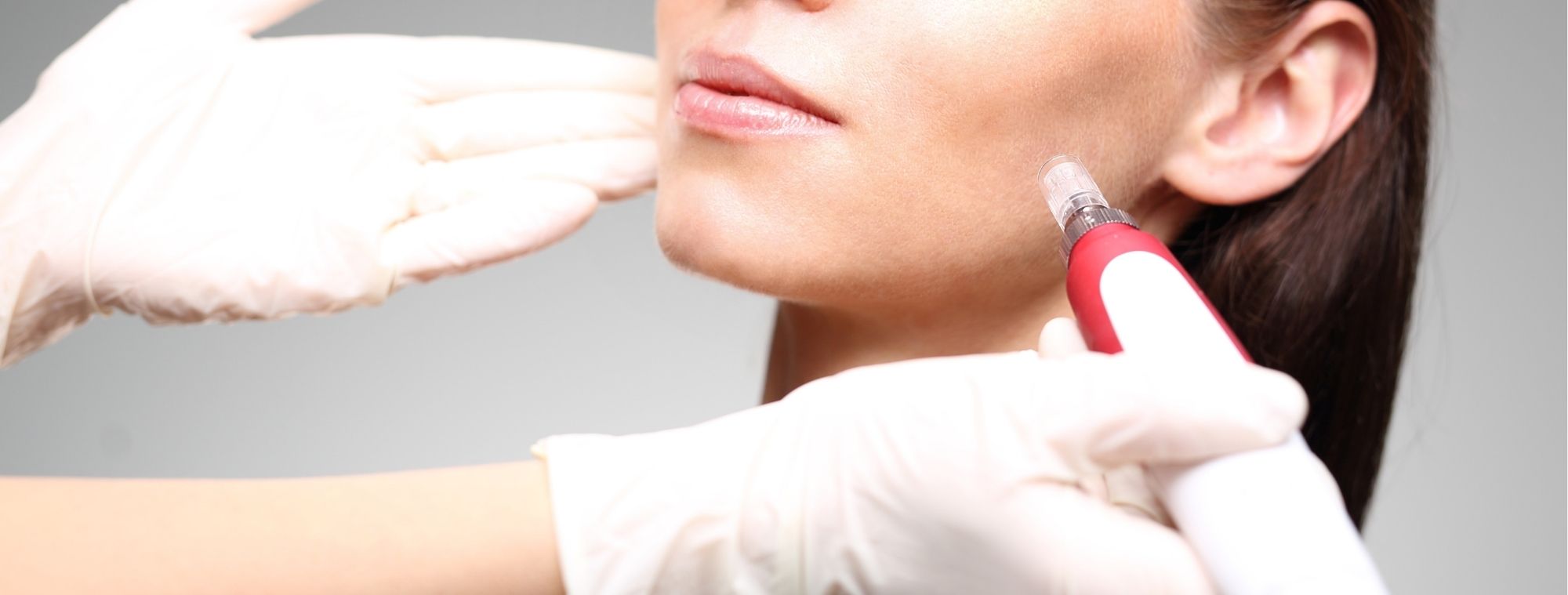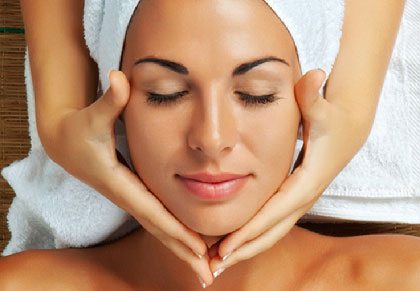
What is Microneedling?
A popular non-surgical aesthetics treatment is microneedling or, also known as micro-needling or collagen induction. microneedling is a non-surgical and minimally invasive skin rejuvenation treatment that uses a micro-needling device. The mico-needling device is moved around the skin to create minor skin injuries. These injuries, in turn, will promote new skin cell growth!
Many aestheticians have hailed microneedling as one of the safest of the newer non-surgical treatments due to the minimal damage it inflicts.
Quick Facts About Microneedling
- The skin is punctured with small needles to encourage the body’s natural healing reaction.
- This process is intended to treat fine lines and wrinkles, acne scars, hyperpigmentation, and other skin issues.
- Skin needling works by inflicting regulated micro-injuries that stimulate the body’s natural synthesis of collagen and elastin, two proteins that contribute to the strength, elasticity, and general health of the skin.
- Microneedling is a rapid and painless procedure with little downtime and few adverse effects.
- Multiple sessions of skin needling may be required to achieve the desired results, depending on the severity of the skin condition being treated.
How does Microneedling Work?
Microneedling, commonly referred to as skin needling or collagen induction treatment, works by inducing regulated micro-injuries in the skin. During the operation, a device with tiny needles punctures the top layer of the skin, producing microscopic channels that activate the body’s natural healing process.
These micro-injuries encourage collagen and elastin formation, two proteins that help the skin’s strength, suppleness, and general health. Collagen is an important component of the skin’s structure, providing firmness and stability, whereas elastin helps the skin to stretch and bounce back to its former shape.
Microneedling, by forming these microscopic channels in the skin, also enables for improved absorption of topical skincare products, such as serums or moisturisers, which may penetrate deeper into the skin and provide more effective benefits.
Types of Microneedling Treatments
There are several types of microneedling treatments available, each with its own specific benefits and considerations. Let us see some of the most common types of microneedling:
Derma roller
A derma roller is a portable instrument with a needle-covered roller. It causes microscopic punctures on the skin as it is rolled over it, stimulating collagen formation and enhancing skin renewal.
Dermapen
The Dermapen is a specialised microneedling device that creates controlled micro-injuries in the skin using a series of adjustable needles. It’s very adjustable and may be used to treat a variety of skin issues.
Radiofrequency microneedling
This combines the benefits of classical microneedling treatment with the skin tightening effects of radiofrequency technology. It can be used to treat drooping skin, fine lines, and wrinkles.
What are the benefits of microneedling treatment for skin?
Microneedling benefits the skin by improving skin texture, limits ageing signs, reduces scarring and blackheads.
Improve Skin Texture
Microneedling improves skin texture by encouraging the production of collagen and elastin. As the body continues to age, there is a decline in the production of two key skin components: elastin and collagen. Microneedling works by encouraging the skin’s healing process to start. This process can take weeks or days, depending on how deep the needles have penetrated the skin. Right after the treatment, the skin will start healing instantly, and the appearance of texture in the skin is noticeably softer.
Scar Treatment
Microneedling will also decrease the appearance of any previous scarring, whether this is scarring from hyperpigmentation or acne scarring. Similarly, to how the micro-needling treatment improves the skin texture. The micro-needling treatment will encourage the production of new cells to replace the damaged skin cells.
Blackhead Treatment
Microneedling will also reduce the reappearance of blackheads and acne. The micro-needles puncture the top layer of the skin (the epidermis), removing recurring blackheads as the needle is coming out of the skin. After this process, the pores become visibly smaller, particularly around the nose.
Slow Ageing
Microneedling will slow down signs of ageing. The needles in the device can activate growth factors in the skin, which helps the repair process. The process works when the body gets stimulated encouraging the natural production of collagen, which reduces fine lines and wrinkles on the skin. microneedling treatments are also a preventative measure for ageing skin. Combining regular microneedling treatments with an effective skincare routine will help the skin look more youthful and glowy. We highly recommend a routine that features powerful antioxidants such as Vitamin C!
Hyperpigmentation Treatment
Microneedling helps to treat hyperpigmentation by promoting the exfoliation of the top layer of the skin, where hyperpigmentation often resides. This helps to remove the excess melanin (pigment) that causes the dark spots or patches associated with hyperpigmentation.
Microneedling creates microchannels in the skin, allowing for better penetration of depigmenting agents such as topical creams or serums that increase collagen levels and can lead to skin rejuvenation, including improved skin tone, texture, and reduced appearance of hyperpigmentation.
Acne Treatment
Microneedling helps diminish the appearance of acne scars. It creates microchannels in the skin that allows better absorption of topical acne medications. This can improve the effectiveness of acne treatments by ensuring deeper penetration into the skin, targeting the underlying causes of acne, such as bacteria, excess oil, and inflammation.
Micro-injuries in the skin help to stimulate collagen production and promote skin remodelling. This process can lead to a smoother skin texture and fading of acne scars over time.
How Many Micro-Needling Treatments will I need?
Before you can start seeing long-lasting results, you will need a few sessions with your aesthetician. The amount you will need will vary depending on the condition of your skin. The condition is dependant on your skins health, elasticity and age.
For example, depending on your acne, it may require at least 4 – 6 sessions for you to see a drastic improvement that will last. Scars may take longer depending on how long they have been there. At your appointment, your aesthetician should be able to advise you on the sessions you will require.
What Are The Side Effects of Microneedling?
As we mentioned previously, microneedling is one of the safest non-surgical aesthetic treatments. This is due to how minimally invasive microneedling treatments are. However, as with any treatment, there are potential temporary side effects. The chances of these side effects will depend on the sensitivity of your skin and the quality of equipment used.
The short term side effects are:
- Swelling
- Redness
- Skin Flaking
- Itchiness
As you can see, the potential side effects are not as serious as when receiving an invasive aesthetic treatment.
Read More: How to become a Non-Medical Aesthetician?
Interested in Learning Microneedling Treatments?
If you’ve been keeping up with our blogs, I’m sure by now you would know how popular the aesthetics industry is! Estimated to reach $73.6bn globally by 2022, this is the best time to join.
At the Ray Cochrane Beauty School, we offer the VTCT Level 4 Certificate in Microneedling. Our course runs over 12 weeks with the future leading aestheticians in mind. Students enrolled on the course are taught by our expert tutors who are also practising aestheticians in Central London!
We also understand that financial roadblocks can get in the way of learning a new skill, which is why we offer a 12-month interest-free payment plan. Simply pay your deposit to secure your spot on the course and spread the rest of the course costs over 12 instalments! You could even be using your profits as a microneedling aesthetician to pay back your course costs! Talk about an investment.
If you would like to find out more about our advanced aesthetic microneedling course, then get in touch with us today. Either you can send us an email to email@raycochrane.co.uk citing ‘Level 4 microneedling course’ in your subject. If you would prefer to speak directly with a member of the enrolment team, then call us on 02074866291.
FAQ’s on Microneedling Treatment and Benefits
How many sessions of microneedling do I need to treat acne scars?
The number of microneedling sessions required for acne scars varies according to the degree of the scarring, as well as the individual’s skin type and response to the therapy. For best results, a series of 3-6 microneedling treatments spaced 4-6 weeks apart is advised.
Which microneedling is best for acne scars?
In general, medical-grade micro-needling devices that penetrate deeper into the skin are thought to be more successful than at-home derma rollers or microneedling pens for healing acne scars. Dermapen, SkinPen, and Collagen P.I.N. are a few examples of successful microneedling treatments for acne scars.
Which is better microneedling or laser treatment?
Whether microneedling or laser therapy is preferable for you depends on your individual skin conditions and the outcomes you want to attain. Microneedling is a minimally invasive therapy that employs small needles to penetrate the skin, stimulating the formation of collagen and elastin. It can be used to treat a range of skin issues. Laser therapy, on the other hand, employs focused beams of light to target specific skin issues. Ultimately, laser treatment is generally more aggressive than microneedling and may require more downtime. It can also be more costly than microneedling.
How microneedling works for hyperpigmentation?
Microneedling works to address hyperpigmentation by activating the skin’s innate healing process and promoting the production of collagen and elastin. The procedure involves the use of fine needles that create micro-injuries in the skin, triggering the body’s natural regeneration process. This leads to the generation of new skin cells and regulation of melanin production, which can help to diminish the appearance of hyperpigmentation.
